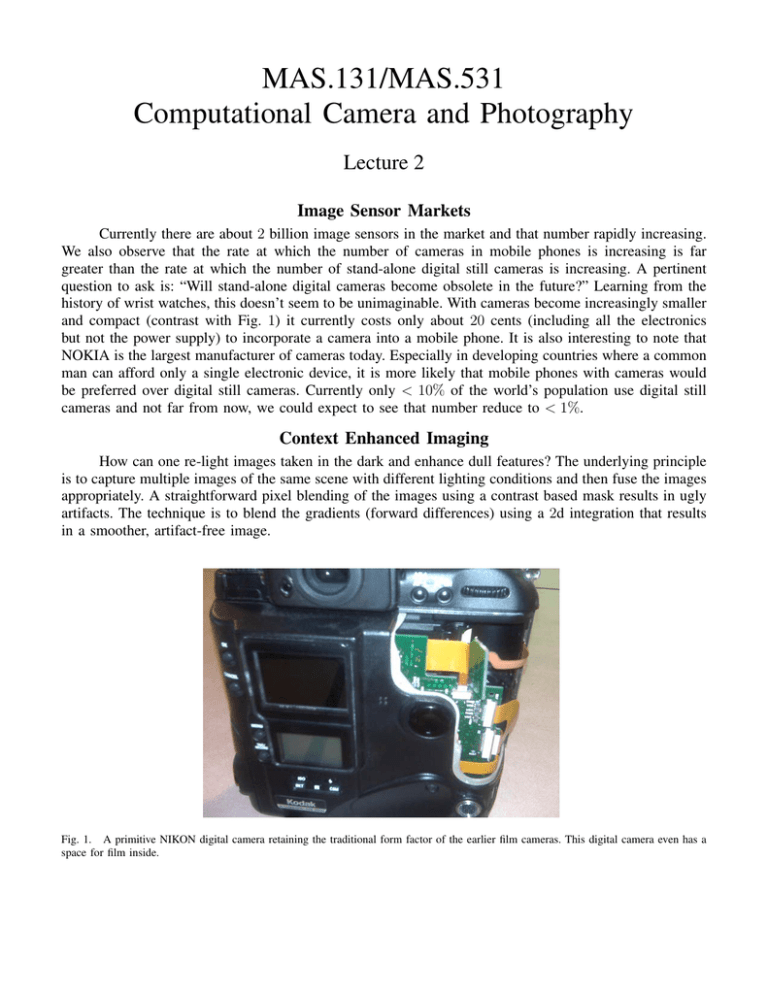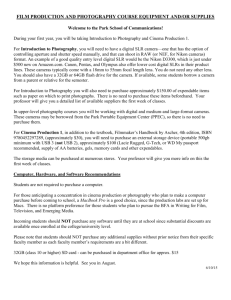Document 13438202
advertisement

MAS.131/MAS.531 Computational Camera and Photography Lecture 2 Image Sensor Markets Currently there are about 2 billion image sensors in the market and that number rapidly increasing. We also observe that the rate at which the number of cameras in mobile phones is increasing is far greater than the rate at which the number of stand-alone digital still cameras is increasing. A pertinent question to ask is: “Will stand-alone digital cameras become obsolete in the future?” Learning from the history of wrist watches, this doesn’t seem to be unimaginable. With cameras become increasingly smaller and compact (contrast with Fig. 1) it currently costs only about 20 cents (including all the electronics but not the power supply) to incorporate a camera into a mobile phone. It is also interesting to note that NOKIA is the largest manufacturer of cameras today. Especially in developing countries where a common man can afford only a single electronic device, it is more likely that mobile phones with cameras would be preferred over digital still cameras. Currently only < 10% of the world’s population use digital still cameras and not far from now, we could expect to see that number reduce to < 1%. Context Enhanced Imaging How can one re-light images taken in the dark and enhance dull features? The underlying principle is to capture multiple images of the same scene with different lighting conditions and then fuse the images appropriately. A straightforward pixel blending of the images using a contrast based mask results in ugly artifacts. The technique is to blend the gradients (forward differences) using a 2d integration that results in a smoother, artifact-free image. Fig. 1. A primitive NIKON digital camera retaining the traditional form factor of the earlier film cameras. This digital camera even has a space for film inside. Evolution of the art of Photography In the past, artists aimed at creating photo-realistic paintings that would closely resemble the object in the painting. In fact, the skill in their paintings was far too advanced to believe that those images were painted (The Hockney - Falco’s thesis of “Secret Knowledge” of optical systems that the artists possessed which helped them create such paintings). But with the advent of cameras, photo-realistic paintings soon became out of place. The ideal artist was then compelled to develop other art forms like Surrealism (Rene Magritee, “Empire of the Light”). However, with the recent developments in computational photography, even surrealism seems to be an easy task. Right now, skilled artists are focussed on developing more abstract art forms that can’t be easily replicated by technology but at the same time preserve the essence of painting. Will the story of photography also turn out to be the same? Would people still be interested in taking photographs of common objects around them? Why take a photo of yet another building? What is the fundamental aspect of imaging that is separate from the technique itself? Tilt Shift, High Dynamic Range (HDR) etc., where cool but not any more. The photos that are currently being tagged as intersting on Flickr are not the scenes we commonly encounter. What is it that will replace a digital still camera? An imaging platform that creates abstract visual art? There is also a need to improve the display systems, to have better interaction in viewing images. We will be exploring this in the later part of the course and is also covered in the recent book by Prof. Raskar and Prof. Tumblin. 6D displays, Khronos projectors etc., fall into this category. Fig. 2. Different kinds of surfaces Retro-reflection Different surfaces respond to the light rays incident on them in different ways as shown in the Fig. 2. We are particularly interested in the Retro-reflective surfaces where the reflected rays are in the same direction as the incident rays. The corner mirror as shown in Fig. 2 is a common example of retro­ reflective object. In addition to the images formed behind both the mirrors, we find another image behind the corner of the mirrors. This image always appears inline with the object and is not flipped from left to right. Human eyes, cat eyes, bike reflectors exhibit retro reflection. Rain drops or water bubbles also exhibit retro-reflection due to total internal reflection which results in rainbows. Note that rainbows are easy to observe in the evenings than in the mornings because the sun would be tangential to the earth along the line of sight in the evenings. CCD cameras also exhibit retro-reflection when the light source is in perfect focus with the camera. This is because the sensors in the camera act as reflectors, reflecting the light in the same direction as the incident light. This technique is used in anti-paparazzi flashes. Demonstration of Fraunhofer Diffraction The fraunhofer diffraction of light as it passes through a diffraction grating was demonstrated during the class. When a light wave of wavelength whose order is of the size of the diffracting objects is incident, it produces a complex pattern of varying intensities. This is due to the superposition of different parts of a wave that travel to the screen along different paths resulting in different phases at the superposition instant. The experimental setup is shown as in Fig. 3. Since air and water are transparent to red laser light, Eosin-water was used to observe the red laser as it passes through water. The following is simple explanation for the floresence of Eosin. The emitted frequency during deexcitation of the Eosin molecules is different from the absorbed frequency during excitation and therefore the emitted light is not re-absored by the neighboring Eosin molecules and hence the floresence. The same light when passed through milk tends to diffuse because the emitted and the absorbed frequencies for milk are approximately the same and hence the neighboring milk molecules absorb the emitted light leading to a diffusion of the light. Fig. 3. Experimental setup to demonstrate the diffraction of light through a grating. The maxima of the diffraction pattern caused by a grating is given by d(sinθm + sinθi ) = mλ where θi is the incident angle, d is the separation of grating elements and m is an integer which refers to the mode. The diffraction of the red light laser was observed to be similar to the one shown in Fig. 4 Fig. 4. The diffraction of red laser as it passes though a grating. Total internal reflection, a phenomenon that occurs when the incident angle of a light ray is at a boundary is greater than the critical angle was also demonstrated using the water/glass boundary. Computational Illumination Consumer photography can truly become professional photography only when illumination is exploited. Just as Edgerton demonstrated in 1930� s, impressive effects can be achieved by just changing the illumina­ tion of the object. One advantage of changing just the position of the illumination is in detecting the depth discontinuties in the image as was demonstrated by Prof. Raksar et. al., using a multi-flash camera. This technique also works when the background is black. However, one can imagine extending this technique to discover depth information in addition to depth discontinuities. Other possible directions for research lie in changing camera parameters in addition to illumination while capturing multiple images, solving matting equations after dividing, doing IR etc., MIT OpenCourseWare http://ocw.mit.edu MAS.531 / MAS.131 Computational Camera and Photography Fall 2009 For information about citing these materials or our Terms of Use, visit: http://ocw.mit.edu/terms.



